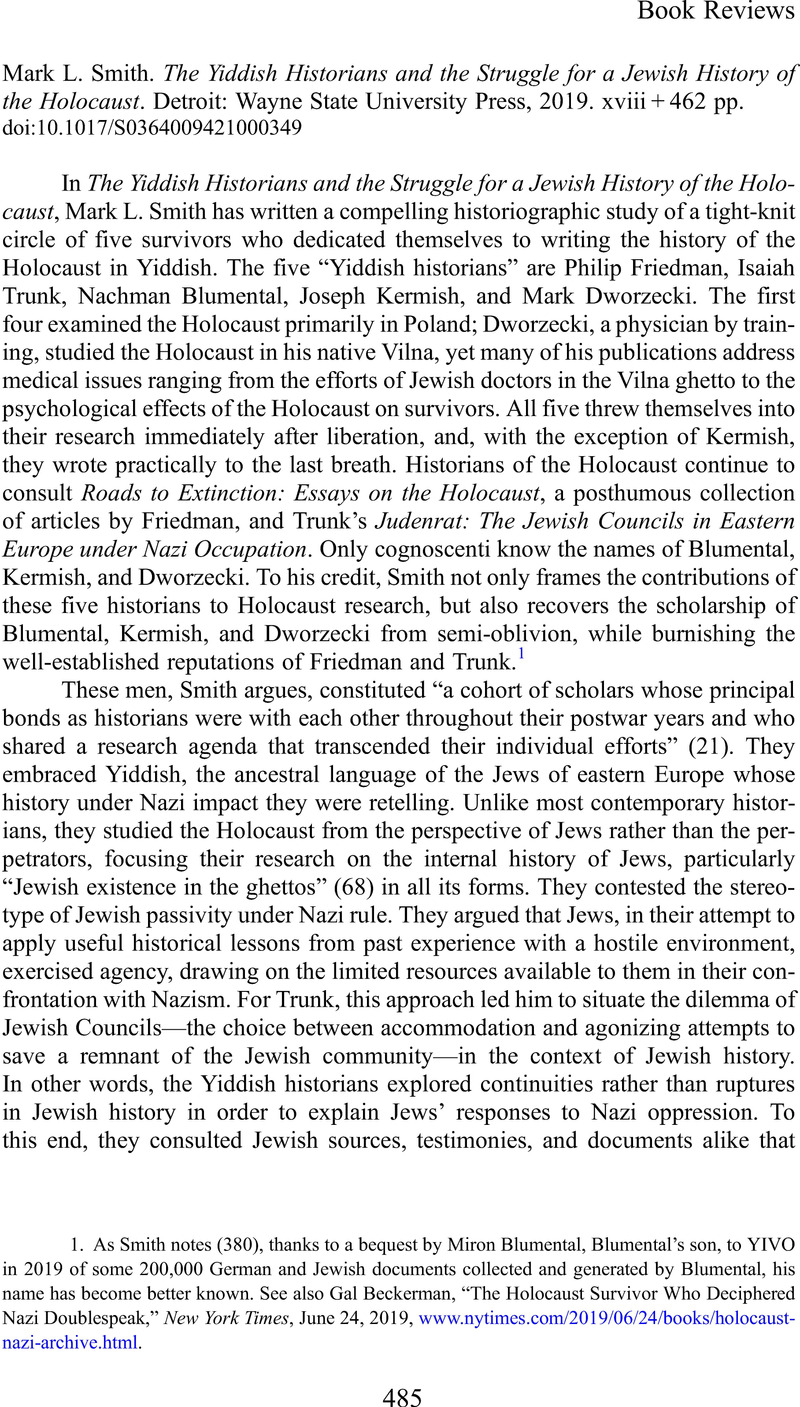No CrossRef data available.
Published online by Cambridge University Press: 08 November 2021

1. As Smith notes (380), thanks to a bequest by Miron Blumental, Blumental's son, to YIVO in 2019 of some 200,000 German and Jewish documents collected and generated by Blumental, his name has become better known. See also Gal Beckerman, “The Holocaust Survivor Who Deciphered Nazi Doublespeak,” New York Times, June 24, 2019, www.nytimes.com/2019/06/24/books/holocaust-nazi-archive.html.
2. See Jockusch, Laura, Collect and Record! Jewish Holocaust Documentation in Early Postwar Europe (New York: Oxford University Press, 2012)CrossRefGoogle Scholar; and Cohen, Boaz, Israeli Holocaust Research: Birth and Evolution, trans. Vazsonyi, Agnes (London: Routledge, 2013)Google Scholar.
3. David Engel argues that Western historians of Jewish history have avoided engagement with the Holocaust under the influence of Salo Baron's promotion of an antilachrymose conception of Jewish history—at the risk of rendering their work irrelevant to a lay readership. Engel, David, Historians of the Jews and the Holocaust (Stanford, CA: Stanford University Press, 2010)Google Scholar. As Smith observes (64n6), “Inclusion of the Yiddish historians in his [Engel's] narrative would not have undermined, but rather validated, his thesis.”
4. Diner, Hasia R., We Remember with Reverence and Love: American Jews and the Myth of Silence after the Holocaust, 1945–1962 (New York: New York University Press, 2010)Google Scholar.
5. On Dawidowicz, see Sinkoff, Nancy, From Left to Right: Lucy S. Dawidowicz, the New York Intellectuals, and the Politics of Jewish History (Detroit: Wayne State University Press, 2020)Google Scholar, and its review in this issue.
6. See, e.g., Stach, Stephan, “‘The Spirit of the Time Left Its Stamp on These Works’: Writing the History of the Shoah at the Jewish Historical Institute in Stalinist Poland,” Remembrance and Solidarity: Studies in 20th-Century European History 5 (December 2016): 185–211Google Scholar; , Stach, “Geschichtsschreibung und politische Vereinnahmungen: Das Jüdische Historische Institut in Warschau, 1947–1968,” Jahrbuch des Simon-Dubnow-Instituts/Simon Dubnow Institute Yearbook 8 (2008): 401–31Google Scholar; and Nalewajko-Kulikov, Joanna, “Trzy kolory: szary. Szkic do portretu Bernarda Marka,” Zagłada Żydów: Studia i Materiały. Pismo Centrum Badań nad Zagładą Żydów 4 (2008): 263–84CrossRefGoogle Scholar. Dawidowicz knew the writings of Mark and his colleagues at the ŻIH. Although she viewed their work with ambivalence, she found things to like in their publications after 1956. See Dawidowicz, Lucy S., The Holocaust and the Historians (Cambridge, MA: Harvard University Press, 1981), 97–107Google Scholar.